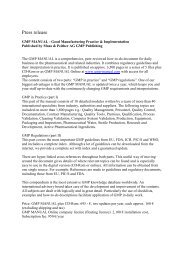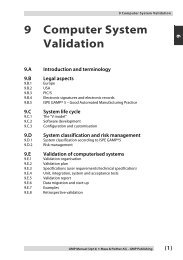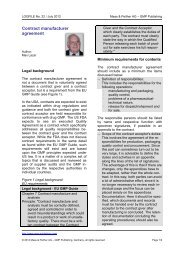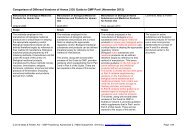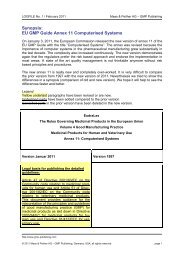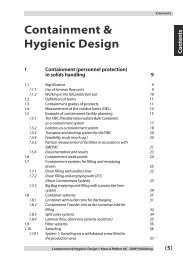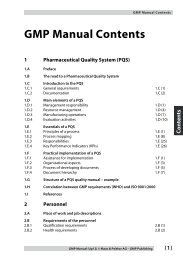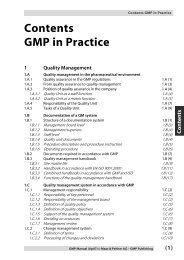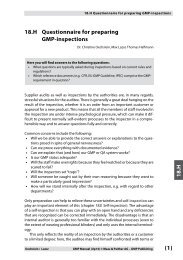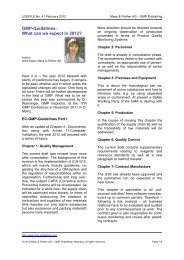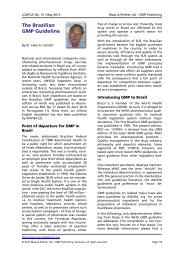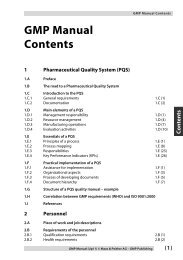Synopsis: EU GMP Guide Chapter 4 Documentation - GMP Publishing
Synopsis: EU GMP Guide Chapter 4 Documentation - GMP Publishing
Synopsis: EU GMP Guide Chapter 4 Documentation - GMP Publishing
- No tags were found...
You also want an ePaper? Increase the reach of your titles
YUMPU automatically turns print PDFs into web optimized ePapers that Google loves.
LOGFILE No. 1 / February 2011Maas & Peither AG – <strong>GMP</strong> <strong>Publishing</strong><strong>Synopsis</strong>:<strong>EU</strong> <strong>GMP</strong> <strong>Guide</strong> <strong>Chapter</strong> 4 <strong>Documentation</strong>On January 3, 2011 the revised version of chapter 4 documentation of part I of the <strong>EU</strong> <strong>GMP</strong><strong>Guide</strong> publised by the European Commission. The chapter was completely reworked and alot of details were adopted to current <strong>GMP</strong> practices in the pharmaceutical industry. A lot ofchanges address the growing use of electronic documentation and data recording. That isalso a reason that annex 11 “Computerised Systems” was revised at the same time.<strong>Chapter</strong> 4 has changed completely and there are only a few identical paragraphs to the priorversion from 2004. The following synopsis shows in detail where changes have been made.We tried to oppose the old paragraphes to the old ones.Legend:Yellow underlaid paragraphs have been revised or are new.Underlined parts have been added compared to the prior versionCancelled parts in the prior version have been deleted in the new version.Version 2011 Version 2004SANCO/C8/AM/sl/ares(2010)1064587EudraLexThe Rules Governing Medicinal Products in the European UnionVolume 4 Good Manufacturing PracticeMedicinal Products for Human and Veterinary Use<strong>Chapter</strong> 4: <strong>Documentation</strong>Legal basis for publishing the detailedguidelines:Article 47 of Directive 2001/83/EC on theCommunity code relating to medicinal productsfor human use and Article 51 of Directive2001/82/EC on the Community coderelating to veterinary medicinal products.This document provides guidance for theinterpretation of the principles and guidelinesof good manufacturing practice (<strong>GMP</strong>) formedicinal products as laid down in Directive2003/94/EC for medicinal products for humanuse and Directive 91/412/EEC for veterinaryuse.http://www.gmp-publishing.com© 2011 Maas & Peither AG – <strong>GMP</strong> <strong>Publishing</strong>, Germany, USA, all rights reserved page 1
LOGFILE No. 1 / February 2011Maas & Peither AG – <strong>GMP</strong> <strong>Publishing</strong>Status of the document:revision 1Reasons for changes:the sections on "generation and control ofdocumentation" and "retention of documents"have been revised, in the light of theincreasing use of electronic documentswithin the <strong>GMP</strong> environment.Deadline for coming into operation:30 June 2011 2004PrinciplePrincipleGood documentation constitutes an essentialpart of the quality assurance system andis key to operating in compliance with <strong>GMP</strong>requirements. The various types of documentsand media used should be fully definedin the manufacturer's Quality ManagementSystem. <strong>Documentation</strong> may exist in avariety of forms, including paper-based, electronicor photographic media. The main objectiveof the system of documentation utilizedmust be to establish, control, monitorand record all activities which directly or indirectlyimpact on all aspects of the quality ofmedicinal products. The Quality ManagementSystem should include sufficient instructionaldetail to facilitate a common understandingof the requirements, in additionto providing for sufficient recording of thevarious processes and evaluation of anyobservations, so that ongoing application ofthe requirements may be demonstrated.There are two primary types of documentationused to manage and record <strong>GMP</strong> compliance:instructions (directions, requirements)and records/reports. Appropriategood documentation practice should be appliedwith respect to the type of document.Suitable controls should be implemented toensure the accuracy, integrity, availabilityand legibility of documents. InstructionGood documentation constitutes an essentialpart of the quality assurance system.Clearly written documentation prevents errorsfrom spoken communication and permitstracing of batch history. Specifications,Manufacturing Formulae and instructions,procedures, and records must be free fromerrors and available in writing. The legibilityof documents is of paramount importance.4.9 Data may be recorded by electronic dataprocessing systems, photographic or otherreliable means, but detailed procedures relatingto the system in use should be availableand the accuracy of the records shouldbe checked.http://www.gmp-publishing.com© 2011 Maas & Peither AG – <strong>GMP</strong> <strong>Publishing</strong>, Germany, USA, all rights reserved page 2
LOGFILE No. 1 / February 2011Maas & Peither AG – <strong>GMP</strong> <strong>Publishing</strong>documents should be free from errors andavailable in writing. The term ‘written’ meansrecorded, or documented on media fromwhich data may be rendered in a humanreadable form.Required <strong>GMP</strong> documentation (by type):Site Master File:A document describing the <strong>GMP</strong> related activitiesof the manufacturer.Instructions (directions, or requirements)type:SpecificationsDescribe in detail the requirements withwhich the products or materials used or obtainedduring manufacture have to conform.They serve as a basis for quality evaluation.Manufacturing Formulae, Processing,Packaging and Testing Instructions:Provide detail all the starting materials,equipment and computerised systems (ifany) to be used and specify all processing,packaging, sampling and testing instructions.Inprocess controls and process analyticaltechnologies to be employed should bespecified where relevant, together with acceptancecriteria.Procedures:(Otherwise known as Standard OperatingProcedures, or SOPs), give directions forperforming certain operations.4.1 Specificationsdescribe in detail the requirements withwhich the products or materials used or obtainedduring manufacture have to conform.They serve as a basis for quality evaluation.Manufacturing Formulae, Processing andPackaging Instructionsstate all the starting materials used and laydown all processing and packaging operations.Proceduresgive directions for performing certain operationse.g. cleaning, clothing, environmentalcontrol, sampling, testing, equipment operation.Protocols:Give instructions for performing and recordingcertain discreet operations.http://www.gmp-publishing.com© 2011 Maas & Peither AG – <strong>GMP</strong> <strong>Publishing</strong>, Germany, USA, all rights reserved page 3
LOGFILE No. 1 / February 2011Maas & Peither AG – <strong>GMP</strong> <strong>Publishing</strong>Technical Agreements:Are agreed between contract givers and acceptorsfor outsourced activities.Record/Report type:Records:Provide evidence of various actions taken todemonstrate compliance with instructions,e.g. activities, events, investigations, and inthe case of manufactured batches a historyof each batch of product, including its distribution.Records include the raw data whichis used to generate other records. For electronicrecords regulated users should definewhich data are to be used as raw data. Atleast, all data on which quality decisions arebased should be defined as raw data4.1 Recordsprovide a history of each batch of product,including its distribution, and also of all otherrelevant circumstances pertinent to the qualityof the final product.Certificates of Analysis:Provide a summary of testing results onsamples of products or materials(1) togetherwith the evaluation for compliance to astated specification.Footnote: (1) Alternatively the certification maybe based, in-whole or in-part, on the assessmentof real time data (summaries andexception reports) from batch related processanalytical technology (PAT), parametersor metrics as per the approved marketingauthorisation dossier.Reports:Document the conduct of particular exercises,projects or investigations, togetherwith results, conclusions and recommendations.Generation and Control of <strong>Documentation</strong>4.1 All types of document should be defined 4.9 Batch records electronically storedhttp://www.gmp-publishing.com© 2011 Maas & Peither AG – <strong>GMP</strong> <strong>Publishing</strong>, Germany, USA, all rights reserved page 4
LOGFILE No. 1 / February 2011Maas & Peither AG – <strong>GMP</strong> <strong>Publishing</strong>and adhered to. The requirements applyequally to all forms of document mediatypes. Complex systems need to be understood,well documented, validated, and adequatecontrols should be in place. Manydocuments (instructions and/or records) mayexist in hybrid forms, i.e. some elements aselectronic and others as paper based. Relationshipsand control measures for masterdocuments, official copies, data handlingand records need to be stated for both hybridand homogenous systems. Appropriatecontrols for electronic documents such astemplates, forms, and master documentsshould be implemented. Appropriate controlsshould be in place to ensure the integrity ofthe record throughout the retention period.should be protected by back-up transfer onmagnetic tape, microfilm, paper or othermeans.4.2 Documents should be designed, prepared,reviewed, and distributed with care.They should comply with the relevant partsof Product Specification Files, Manufacturingand Marketing Authorisation dossiers, asappropriate. The reproduction of workingdocuments from master documents shouldnot allow any error to be introduced throughthe reproduction process.4.1 Documents should be designed, prepared,reviewed and distributed with care.They should comply with the relevant partsof the manufacturing and marketing authorisationdossiers.4.3 Documents containing instructionsshould be approved, signed and dated byappropriate and authorised persons. Documentsshould have unambiguous contentsand be uniquely identifiable. The effectivedate should be defined.4.3 Documents should be approved, signedand dated by appropriate and authorisedpersons.4.4 Documents should have unambiguouscontents; title, nature and purpose should beclearly stated. […] Reproduced documentsshould be clear and legible. The reproductionof working documents from masterdocuments must not allow any error to beintroduced through the reproduction process.4.9 If documentation is handled by electronicdata processing methods, only authorisedpersons should be able to enter or modifydata in the computer and there should be arecord of changes and deletions; accessshould be restricted by passwords or othermeans and the result of entry of critical datashould be independently checked.http://www.gmp-publishing.com© 2011 Maas & Peither AG – <strong>GMP</strong> <strong>Publishing</strong>, Germany, USA, all rights reserved page 5
LOGFILE No. 1 / February 2011Maas & Peither AG – <strong>GMP</strong> <strong>Publishing</strong>4.4 Documents containing instructionsshould be laid out in an orderly fashion andbe easy to check. The style and language ofdocuments should fit with their intended use.Standard Operating Procedures, Work Instructionsand Methods should be written inan imperative mandatory style.4.4. […] They should be laid out in an orderlyfashion and be easy to check.4.5 Documents within the Quality ManagementSystem should be regularly reviewedand kept up-to-date.4.5 Documents should be regularly reviewedand kept up-to-date. When a document hasbeen revised, systems should be operated toprevent inadvertent use of supersededdocuments.4.6 Documents should not be hand-written;although, where documents require the entryof data, sufficient space should be providedfor such entries.4.6 Documents should not be handwritten;although, where documents require the entryof data, […] Sufficient space should be providedfor such entries.Good <strong>Documentation</strong> Practices4.7 Handwritten entries should be made inclear, legible, indelible way.4.6 […] these entries may be made in clear,legible, indelible handwriting. […]4.8 Records should be made or completedat the time each action is taken and in sucha way that all significant activities concerningthe manufacture of medicinal products aretraceable.4.8 The records should be made or completedat the time each action is taken and insuch a way that all significant activities concerningthe manufacture of medicinal productsare traceable. They should be retainedfor at least one year after the expiry date ofthe finished product.4.9 Any alteration made to the entry on adocument should be signed and dated; thealteration should permit the reading of theoriginal information. Where appropriate, thereason for the alteration should be recorded.4.7 Any alteration made to the entry on adocument should be signed and dated; thealteration should permit the reading of theoriginal information. Where appropriate, thereason for the alteration should be recorded.Retention of Documents4.10 It should be clearly defined which recordis related to each manufacturing activityhttp://www.gmp-publishing.com© 2011 Maas & Peither AG – <strong>GMP</strong> <strong>Publishing</strong>, Germany, USA, all rights reserved page 6
LOGFILE No. 1 / February 2011Maas & Peither AG – <strong>GMP</strong> <strong>Publishing</strong>and where this record is located. Securecontrols must be in place to ensure the integrityof the record throughout the retentionperiod and validated where appropriate.4.11 Specific requirements apply to batchdocumentation which must be kept for oneyear after expiry of the batch to which it relatesor at least five years after certificationof the batch by the Qualified Person, whicheveris the longer. For investigational medicinalproducts, the batch documentationmust be kept for at least five years after thecompletion or formal discontinuation of thelast clinical trial in which the batch was used.Other requirements for retention of documentationmay be described in legislation inrelation to specific types of product (e.g. AdvancedTherapy Medicinal Products) andspecify that longer retention periods be appliedto certain documents.4.12 For other types of documentation, theretention period will depend on the businessactivity which the documentation supports.Critical documentation, including raw data(for example relating to validation or stability),which supports information in the MarketingAuthorisation should be retainedwhilst the authorization remains in force. Itmay be considered acceptable to retire certaindocumentation (e.g. raw data supportingvalidation reports or stability reports) wherethe data has been superseded by a full setof new data. Justification for this should bedocumented and should take into accountthe requirements for retention of batchdocumentation; for example, in the case ofprocess validation data, the accompanyingraw data should be retained for a period atleast as long as the records for all batcheswhose release has been supported on thebasis of that validation exercise.The following section gives some examplesof required documents. The quality managementsystem should describe all documentsrequired to ensure product quality and patientsafety.http://www.gmp-publishing.com© 2011 Maas & Peither AG – <strong>GMP</strong> <strong>Publishing</strong>, Germany, USA, all rights reserved page 7
LOGFILE No. 1 / February 2011Maas & Peither AG – <strong>GMP</strong> <strong>Publishing</strong>SpecificationsSpecifications4.13 There should be appropriately authorisedand dated specifications for starting andpackaging materials, and finished products.Specifications for starting and packagingmaterials4.10 There should be appropriately authorisedand dated specifications for starting andpackaging materials, and finished products;where appropriate, they should be alsoavailable for intermediate or bulk products.Specifications for starting and packagingmaterials4.14 Specifications for starting and primaryor printed packaging materials should includeor provide reference to, if applicable:a) A description of the materials, including:- The designated name and the internal codereference;- The reference, if any, to a pharmacopoeialmonograph;- The approved suppliers and, if reasonable,the original producer of the material;- A specimen of printed materials;b) Directions for sampling and testing;c) Qualitative and quantitative requirementswith acceptance limits;d) Storage conditions and precautions;e) The maximum period of storage before reexamination.Specifications for intermediate and bulkproducts4.11 Specifications for starting and primaryor printed packaging materials should include,if applicable:a) a description of the materials, including:- the designated name and the internal codereference;- the reference, if any, to a pharmacopoeialmonograph;- the approved suppliers and, if possible, theoriginal producer of the products;- a specimen of printed materials;b) directions for sampling and testing or referenceto procedures;c) qualitative and quantitative requirementswith acceptance limits;d) storage conditions and precautions;e) the maximum period of storage before reexamination.Specifications for intermediate and bulkproducts4.15 Specifications for intermediate and bulkproducts should be available for critical stepsor if these are purchased or dispatched. Thespecifications should be similar to specifica-4.12 Specifications for intermediate and bulkproducts should be available if these arepurchased or dispatched, or if data obtainedfrom intermediate products are used for thehttp://www.gmp-publishing.com© 2011 Maas & Peither AG – <strong>GMP</strong> <strong>Publishing</strong>, Germany, USA, all rights reserved page 8
LOGFILE No. 1 / February 2011Maas & Peither AG – <strong>GMP</strong> <strong>Publishing</strong>tions for starting materials or for finishedproducts, as appropriate.Specifications for finished productsevaluation of the finished product. The specificationsshould be similar to specificationsfor starting materials or for finished products,as appropriate.Specifications for finished products4.16 Specifications for finished productsshould include or provide reference to:a) The designated name of the product andthe code reference where applicable;b) The formula;c) A description of the pharmaceutical formand package details;d) Directions for sampling and testinge) The qualitative and quantitative requirements,with the acceptance limits;f) The storage conditions and any specialhandling precautions, where applicable;g) The shelf-life.Manufacturing Formula and ProcessingInstructions4.13 Specifications for finished productsshould include:a) the designated name of the product andthe code reference where applicable;b) the formula or a reference to;c) a description of the pharmaceutical formand package details;d) directions for sampling and testing or areference to procedures;e) the qualitative and quantitative requirements,with the acceptance limits;f) the storage conditions and any specialhandling precautions, where applicable;g) the shelf-life.Manufacturing Formula and ProcessingInstructionsApproved, written Manufacturing Formulaand Processing Instructions should exist foreach product and batch size to be manufactured.Formally authorised Manufacturing Formulaand Processing Instructions should exist foreach product and batch size to be manufactured.They are often combined in onedocument.4.17 The Manufacturing Formula should include:a) The name of the product, with a productreference code relating to its specification;b) A description of the pharmaceutical form,strength of the product and batch size;4.14 The Manufacturing Formula should include:a) the name of the product, with a productreference code relating to its specification;b) a description of the pharmaceutical form,strength of the product and batch size;http://www.gmp-publishing.com© 2011 Maas & Peither AG – <strong>GMP</strong> <strong>Publishing</strong>, Germany, USA, all rights reserved page 9
LOGFILE No. 1 / February 2011Maas & Peither AG – <strong>GMP</strong> <strong>Publishing</strong>c) A list of all starting materials to be used,with the amount of each, described; mentionshould be made of any substance that maydisappear in the course of processing;d) A statement of the expected final yieldwith the acceptable limits, and of relevantintermediate yields, where applicablec) a list of all starting materials to be used,with the amount of each, described using thedesignated name and a reference which isunique to that material; mention should bemade of any substance that may disappearin the course of processing;d) a statement of the expected final yieldwith the acceptable limits, and of relevantintermediate yields, where applicable..4.18 The Processing Instructions shouldinclude:a) A statement of the processing locationand the principal equipment to be used;b) The methods, or reference to the methods,to be used for preparing the criticalequipment (e.g. cleaning, assembling, calibrating,sterilising);c) Checks that the equipment and work stationare clear of previous products, documentsor materials not required for theplanned process, and that equipment isclean and suitable for use;d) Detailed stepwise processing instructions[e.g. checks on materials, pre-treatments,sequence for adding materials, critical processparameters (time, temp etc)];e) The instructions for any in-process controlswith their limits;f) Where necessary, the requirements forbulk storage of the products; including thecontainer, labeling and special storage conditionswhere applicable;4.15 The Processing Instructions shouldinclude:a) a statement of the processing locationand the principal equipment to be used;b) the methods, or reference to the methods,to be used for preparing the critical equipment(e.g. cleaning, assembling, calibrating,sterilising);c) detailed stepwise processing instructions(e.g. checks on materials, pre-treatments,sequence for adding materials, mixing times,temperatures);d) the instructions for any in-process controlswith their limits;e) where necessary, the requirements forbulk storage of the products; including thecontainer, labelling and special storage conditionswhere applicable;f) any special precautions to be observed.g) Any special precautions to be observed.Packaging InstructionsPackaging Instructions4.19 Approved Packaging Instructions foreach product, pack size and type shouldexist.4.16 There should be formally authorisedPackaging Instructions for each product,pack size and type.http://www.gmp-publishing.com© 2011 Maas & Peither AG – <strong>GMP</strong> <strong>Publishing</strong>, Germany, USA, all rights reserved page 10
LOGFILE No. 1 / February 2011Maas & Peither AG – <strong>GMP</strong> <strong>Publishing</strong>These should include, or have a referenceto, the following:a) Name of the product; including the batchnumber of bulk and finished productb) Description of its pharmaceutical form,and strength where applicable;c) The pack size expressed in terms of thenumber, weight or volume of the product inthe final container;d) A complete list of all the packaging materialsrequired, including quantities, sizes andtypes, with the code or reference numberrelating to the specifications of each packagingmaterial;e) Where appropriate, an example or reproductionof the relevant printed packagingmaterials, and specimens indicating whereto apply batch number references, and shelflife of the product;f) Checks that the equipment and work stationare clear of previous products, documentsor materials not required for theplanned packaging operations (line clearance),and that equipment is clean and suitablefor use.g) Special precautions to be observed, includinga careful examination of the areaand equipment in order to ascertain the lineclearance before operations begin;These should normally include, or have areference to, the following:a) name of the product;b) description of its pharmaceutical form, andstrength where applicable;c) the pack size expressed in terms of thenumber, weight or volume of the product inthe final container;d) a complete list of all the packaging materialsrequired for a standard batch size, includingquantities, sizes and types, with thecode or reference number relating to thespecifications of each packaging material;e) where appropriate, an example or reproductionof the relevant printed packagingmaterials, and specimens indicating whereto apply batch number references, and shelflife of the product;f) special precautions to be observed, includinga careful examination of the area andequipment in order to ascertain the lineclearance before operations begin;g) a description of the packaging operation,including any significant subsidiary operations,and equipment to be used;h) details of in-process controls with instructionsfor sampling and acceptance limits.h) A description of the packaging operation,including any significant subsidiary operations,and equipment to be used;i) Details of in-process controls with instructionsfor sampling and acceptance limits.Batch Processing RecordBatch Processing Records4.20 A Batch Processing Record should bekept for each batch processed. It should bebased on the relevant parts of the currently4.17 A Batch Processing Record should bekept for each batch processed. It should bebased on the relevant parts of the currentlyhttp://www.gmp-publishing.com© 2011 Maas & Peither AG – <strong>GMP</strong> <strong>Publishing</strong>, Germany, USA, all rights reserved page 11
LOGFILE No. 1 / February 2011Maas & Peither AG – <strong>GMP</strong> <strong>Publishing</strong>approved Manufacturing Formula and ProcessingInstructions, and should contain thefollowing information:a) The name and batch number of the product;b) Dates and times of commencement, ofsignificant intermediate stages and of completionof production;c) Identification (initials) of the operator(s)who performed each significant step of theprocess and, where appropriate, the name ofany person who checked these operations;d) The batch number and/or analytical controlnumber as well as the quantities of eachstarting material actually weighed (includingthe batch number and amount of any recoveredor reprocessed material added);e) Any relevant processing operation orevent and major equipment used;f) A record of the in-process controls and theinitials of the person(s) carrying them out,and the results obtained;g) The product yield obtained at different andpertinent stages of manufacture;h) Notes on special problems including details,with signed authorisation for any deviationfrom the Manufacturing Formula andProcessing Instructions;i) Approval by the person responsible for theprocessing operations.Note: Where a validated process is continuouslymonitored and controlled, then automaticallygenerated reports may be limited tocompliance summaries and exception/ outofspecification(OOS) data reports.approved Manufacturing Formula and ProcessingInstructions. The method of preparationof such records should be designed toavoid transcription errors. The record shouldcarry the number of the batch being manufactured.Before any processing begins, there shouldbe recorded checks that the equipment andwork station are clear of previous products,documents or materials not required for theplanned process, and that equipment isclean and suitable for use.During processing, the following informationshould be recorded at the time each action istaken and, after completion, the recordshould be dated and signed in agreement bythe person responsible for the processingoperations:a) the name of the product;b) dates and times of commencement, ofsignificant intermediate stages and of completionof production;c) name of the person responsible for eachstage of production;d) initials of the operator of different significantsteps of production and, where appropriate,of the person who checked each ofthese operations (e.g. weighing);e) the batch number and/or analytical controlnumber as well as the quantities of eachstarting material actually weighed (includingthe batch number and amount of any recoveredor reprocessed material added);f) any relevant processing operation or eventand major equipment used;g) a record of the in-process controls and theinitials of the person(s) carrying them out,and the results obtained;h) the product yield obtained at different andpertinent stages of manufacture;http://www.gmp-publishing.com© 2011 Maas & Peither AG – <strong>GMP</strong> <strong>Publishing</strong>, Germany, USA, all rights reserved page 12
LOGFILE No. 1 / February 2011Maas & Peither AG – <strong>GMP</strong> <strong>Publishing</strong>i) notes on special problems including details,with signed authorisation for any deviationfrom the Manufacturing Formula andProcessing Instructions.Batch Packaging RecordBatch Packaging Records4.21 A Batch Packaging Record should bekept for each batch or part batch processed.It should be based on the relevant parts ofthe Packaging Instructions.The batch packaging record should containthe following information:a) The name and batch number of the product,b) The date(s) and times of the packagingoperations;c) Identification (initials) of the operator(s)who performed each significant step of theprocess and, where appropriate, the name ofany person who checked these operations;d) Records of checks for identity and conformitywith the packaging instructions, includingthe results of in-process controls;e) Details of the packaging operations carriedout, including references to equipmentand the packaging lines used;f) Whenever possible, samples of printedpackaging materials used, including specimensof the batch coding, expiry dating andany additional overprinting;g) Notes on any special problems or unusualevents including details, with signed authorisationfor any deviation from the PackagingInstructions;h) The quantities and reference number oridentification of all printed packaging materialsand bulk product issued, used, destroyedor returned to stock and the quantities ofobtained product, in order to provide for an4.18 A Batch Packaging Record should bekept for each batch or part batch processed.It should be based on the relevant parts ofthe Packaging Instructions and the methodof preparation of such records should bedesigned to avoid transcription errors. Therecord should carry the batch number andthe quantity of bulk product to be packed, aswell as the batch number and the plannedquantity of finished product that will be obtained.Before any packaging operation begins,there should be recorded checks that theequipment and work station are clear of previousproducts, documents or materials notrequired for the planned packaging operations,and that equipment is clean and suitablefor use.The following information should be enteredat the time each action is taken and, aftercompletion, the record should be dated andsigned in agreement by the person(s) responsiblefor the packaging operations:a) the name of the product;b) the date(s) and times of the packagingoperations;c) the name of the responsible person carryingout the packaging operation;d) the initials of the operators of the differentsignificant steps;e) records of checks for identity and conformitywith the packaging instructions includingthe results of in-process controls;f) details of the packaging operations carriedhttp://www.gmp-publishing.com© 2011 Maas & Peither AG – <strong>GMP</strong> <strong>Publishing</strong>, Germany, USA, all rights reserved page 13
LOGFILE No. 1 / February 2011Maas & Peither AG – <strong>GMP</strong> <strong>Publishing</strong>adequate reconciliation. Where there arethere are robust electronic controls in placeduring packaging there may be justificationfor not including this informationi) Approval by the person responsible for thepackaging operationsout, including references to equipment andthe packaging lines used;g) whenever possible, samples of printedpackaging materials used, including specimensof the batch coding, expiry dating andany additional overprinting;h) notes on any special problems or unusualevents including details, with signed authorisationfor any deviation from the ManufacturingFormula and Processing Instructions;i) the quantities and reference number oridentification of all printed packaging materialsand bulk product issued, used, destroyedor returned to stock and the quantities ofobtained product, in order to provide for anadequate reconciliation.Procedures and recordsProcedures and recordsReceiptReceipt4.22 There should be written procedures andrecords for the receipt of each delivery ofeach starting material, (including bulk, intermediateor finished goods), primary, secondaryand printed packaging materials.4.19 There should be written procedures andrecords for the receipt of each delivery ofeach starting and primary and printed packagingmaterial.4.23 The records of the receipts should include:a) The name of the material on the deliverynote and the containers;b) The "in-house" name and/or code of material(if different from a);c) Date of receipt;d) Supplier’s name and, manufacturer’sname;e) Manufacturer’s batch or reference number;f) Total quantity and number of containers4.20 The records of the receipts should include:a) the name of the material on the deliverynote and the containers;b) the "in-house" name and/or code of material(if different from a);c) date of receipt;d) supplier’s name and, if possible, manufacturer’sname;e) manufacturer’s batch or reference number;f) total quantity, and number of containershttp://www.gmp-publishing.com© 2011 Maas & Peither AG – <strong>GMP</strong> <strong>Publishing</strong>, Germany, USA, all rights reserved page 14
LOGFILE No. 1 / February 2011Maas & Peither AG – <strong>GMP</strong> <strong>Publishing</strong>received;g) The batch number assigned after receipt;h) Any relevant comment.received;g) the batch number assigned after receipt;h) any relevant comment (e.g. state of thecontainers).4.24 There should be written procedures forthe internal labeling, quarantine and storageof starting materials, packaging materialsand other materials, as appropriate.Sampling4.21 There should be written procedures forthe internal labelling, quarantine and storageof starting materials, packaging materialsand other materials, as appropriate.Sampling4.25 There should be written procedures forsampling, which include the methods andequipment to be used, the amounts to betaken and any precautions to be observed toavoid contamination of the material or anydeterioration in its quality.Testing4.22 There should be written procedures forsampling, which include the person(s)authorised to take samples, the methodsand equipment to be used, the amounts tobe taken and any precautions to be observedto avoid contamination of the materialor any deterioration in its quality (see <strong>Chapter</strong>6, item 13).Testing4.26 There should be written procedures fortesting materials and products at differentstages of manufacture, describing the methodsand equipment to be used. The testsperformed should be recorded.Other4.23 There should be written procedures fortesting materials and products at differentstages of manufacture, describing the methodsand equipment to be used. The testsperformed should be recorded (see <strong>Chapter</strong>6, item 17).Other4.27 Written release and rejection proceduresshould be available for materials andproducts, and in particular for the certificationfor sale of the finished product by theQualified Person(s). All records should beavailable to the Qualified Person. A systemshould be in place to indicate special observationsand any changes to critical data.4.24 Written release and rejection proceduresshould be available for materials andproducts, and in particular for the release forsale of the finished product by the QualifiedPerson(s) in accordance with the requirementsof Article 51 of Directive 2001/83/EC(Article 55 of Directive 2001/82/EC).4.28 Records should be maintained for the 4.25 Records should be maintained of thehttp://www.gmp-publishing.com© 2011 Maas & Peither AG – <strong>GMP</strong> <strong>Publishing</strong>, Germany, USA, all rights reserved page 15
LOGFILE No. 1 / February 2011Maas & Peither AG – <strong>GMP</strong> <strong>Publishing</strong>distribution of each batch of a product in orderto facilitate recall of any batch, if necessary.distribution of each batch of a product in orderto facilitate the recall of the batch if necessary(see <strong>Chapter</strong> 8).4.29 There should be written policies, procedures,protocols, reports and the associatedrecords of actions taken or conclusionsreached, where appropriate, for the followingexamples:- Validation and qualification of processes,equipment and systems;- Equipment assembly and calibration;- Technology transfer;- Maintenance, cleaning and sanitation;- Personnel matters including signature lists,training in <strong>GMP</strong> and technical matters, clothingand hygiene and verification of the effectivenessof training.- Environmental monitoring;- Pest control;4.26 There should be written procedures andthe associated records of actions taken orconclusions reached, where appropriate, for:- validation;- equipment assembly and calibration;- maintenance, cleaning and sanitation;- personnel matters including training, clothing,hygiene;- environmental monitoring;- pest control;- complaints;- recalls;- returns.- Complaints;- Recalls;- Returns;- Change control;- Investigations into deviations and nonconformances;- Internal quality/<strong>GMP</strong> compliance audits;- Summaries of records where appropriate(e.g. product quality review);- Supplier audits.4.30 Clear operating procedures should beavailable for major items of manufacturingand test equipment.4.27 Clear operating procedures should beavailable for major items of manufacturingand test equipment.http://www.gmp-publishing.com© 2011 Maas & Peither AG – <strong>GMP</strong> <strong>Publishing</strong>, Germany, USA, all rights reserved page 16
LOGFILE No. 1 / February 2011Maas & Peither AG – <strong>GMP</strong> <strong>Publishing</strong>4.31 Logbooks should be kept for major orcritical analytical testing, production equipment,and areas where product has beenprocessed. They should be used to record inchronological order, as appropriate, any useof the area, equipment/method, calibrations,maintenance, cleaning or repair operations,including the dates and identity of peoplewho carried these operations out.4.28 Log books should be kept for major orcritical equipment recording, as appropriate,any validations, calibrations, maintenance,cleaning or repair operations, including thedates and identity of people who carriedthese operations out.4.29 Log books should also record inchronological order the use of major or criticalequipment and the areas where theproducts have been processed.4.32 An inventory of documents within theQuality Management System should bemaintained.PTER 4 DOCUMENTATIONThe synopsis has been compiled by:Maas & Peither AG, <strong>GMP</strong> <strong>Publishing</strong>Maas & Peither America, Inc.Karlstrasse 2, 79650 Schopfheim, 1060 First Avenue, Suite 400Deutschland13. Januar 2010King of Prussia, PA 19406, USA<strong>GMP</strong> MANUALGood Manufacturing Practice &ImplementationThe c<strong>GMP</strong> knowledge source for professionalsin the pharmaceutical industryUse the <strong>GMP</strong> MANUAL as• Paper version incl. CD-Rom• CD-Rom• Online aso Named User Licenceo Corporate LicenceMore informationwww.gmp-publishing.com/en/gmp-manual.htmlhttp://www.gmp-publishing.com© 2011 Maas & Peither AG – <strong>GMP</strong> <strong>Publishing</strong>, Germany, USA, all rights reserved page 17
LOGFILE No. 1 / February 2011Maas & Peither AG – <strong>GMP</strong> <strong>Publishing</strong>http://www.gmp-publishing.com© 2011 Maas & Peither AG – <strong>GMP</strong> <strong>Publishing</strong>, Germany, USA, all rights reserved page 18




